The publicity image for one of Michaela Eichwald’s recent gallery exhibitions pictured an unstretched painting that hung lopsided and precariously over a balcony railing. Bitte abholen und wegbringen (please pick up and take away) read its painted letters, visible from the street below. More like a desperate plea than a polite request and suggesting that the discarded object (or even the artist herself) be carted off, bitte—this snapshot of the German artist’s work speaks volumes about her uncompromising unraveling of what is thought to be art history’s most noble medium: painting.
How long had her painting been hanging there? Had the wind, rain, the elements, become part of the making of the work? After all, Eichwald is known to have stepped on, stuck things to, stained, smudged, or otherwise mistreated her paintings before stretching and displaying them on a wall. It’s not that she doesn’t care about them. She cares deeply, emphatically, about painting, calling its problems “endlessly beautiful and inexhaustible.” Her attitude towards painting is, in fact, probably precisely the reason why she dares to take on its problems so boldly and relentlessly while assailing traditional ideas of what counts as “good form”— all in order to lend the medium continued relevance.
Eichwald was not, in fact, formally trained in painting. She studied philosophy, history, art history, and German philology in Cologne in the late 1980s and through to the early 2000s, when the city seemed to be the center of the European artworld. Her art education came instead through informal encounters with the likes of her slightly senior contemporaries, from Michael Krebber and Cosima von Bonin to Jutta Koether and Diedrich Diederichsen, and through reading magazines like Spex and Texte zur Kunst. Eichwald wrote texts and poetry, and by age thirty decided to be an artist, but it “didn’t function at all,” she explains: hardly anything she made was deemed sellable. And a studio was an unimaginable luxury that almost no one in her circle could afford. A “non-productive attitude” so well described by fellow artist Josef Strau reigned in the city. By her own account, it would take another fifteen years for her to arrive in the artworld, an arrival marked by the first sale of a large-scale artwork.
She experimented with video in the 1990s and then went on to make photographs, works on paper, and sculptures, the latter comprised of wonky forms cast in resin and filled with carefully selected bits of everyday life, like chicken bones, pencil erasers, Halloween candy, and even little drawings frozen in ethereal bubbles of epoxy. But it is painting that captures her attention the most, and it is the focus of this presentation of all-new work in her first institutional solo show in Switzerland. Characteristic of her painting from the start is the choice of unconventional supports and “paint.” Read her material lists to find not just a painter’s usual arsenal of acrylic or oil paint, but lacquer, shellac ink, spray paint, fake blood, graphite, wood stain, metallic marker, or stickers. These adhere to, and thicken on, the surfaces of printed polyurethane fabrics or colored pleathers—sometimes with the puckered surfaces of faux ostrich skin or glitter-speckled divots. In other words: textiles originally intended for the interior roof of a car or its seat upholstery, a tabletop or wall covering—anything but painting. Upon these repurposed surfaces the artist asserts a vaguely figurative expressionism: dripping, oozing forms float, like an eviscerated intestinal tract or a jellyfish in ocean water. And they are just as oddly attractive and repulsive as the living matter they evoke.
The plastified surfaces on which Eichwald paints are more rubbery and flexible than a painter’s typical linen or cotton canvas. She likes instead the way these synthetic materials feel when they are stretched, or when her fingers or brushes push against their surfaces. Bought in non-art contexts and dispensing with preparatory layers of gesso normally applied to raw canvas, these substrates allow freedoms that traditional materials wouldn’t offer. But they also court a certain unpredictability. The artist’s palette of scarlet reds, chocolate browns, and piss-stain yellows never fully amalgamates with its support, sometimes remaining still viscous and tacky long after having been painted. This seems fitting as her’s is the opposite of a “licked” finish that academic painters were long at pains to create, smoothing the surface of a painting so that the presence of the artist's hand would no longer be visible. And she refuses her materials and forms any kind of transcendence—neon orange polyurethane looks every bit like the repurposed material that it is, and a scrawled outline of a swine or squid only unconvincingly evokes the real thing. The outcomes might trouble perception as much as they do so-called good taste, but that doesn’t stop them from also being at times strangely beautiful, even sublime.
This troubling cuts to the heart of how Eichwald’s paintings operate. In front of almost any other painting—whether historic or contemporary, figurative or abstract—one usually knows what to make of it: whether it represents a chicken or a cowboy, whether you like it or not, whether you think it is successful or not. And to return to that same painting minutes or days or years later usually confirms those same first impressions or emotions. But to look at any one of Eichwald’s paintings is to be continually unsettled, to be not quite sure of anything. Maybe certainties are so fugitive because the formal and material aspects of her paintings—based on deliberate decisions that only appear haphazard and exhibiting a peculiar elegance that comes from the deft control of chaos—give the impression of sharing with an audience their process of becoming. Like paint that never quite dries, or like a run-on sentence that never settles into one single meaning.
Comprehending her painterly expression as a run-on sentence is somehow appropriate. A reader of poetry and a writer regularly publishing on uhutrust.com, the lo-fi blog she began in the early 2000s, Eichwald deploys language as the backbone of her practice. Sometimes text is brought onto the surfaces of her paintings but more often than not her idiosyncratic poetic sense makes its way into her titles. It is there that her ironic, self-deprecating attitude is most clearly articulated, juxtaposing references to medieval mysticism or theology with sly digs at a consumerist society. Quotes and aphorisms like Was gesagt wird, ist egal. Was Sache ist, darum geht’s (What is being said is irrelevant. The thing is what it is all about, 2020) sit alongside the onomatopoetic, gbr gbr trt, or CityHome 2000 Titelgenerator (CityHome 2000 Title Generator), the latter literally taking the name of the Munich hotel (CityHome 2000) she was staying in when she had to come up with a title for the work. Playful and sincere she is, in a way that allows her singular relationship to language and paint and surface to come together in an oeuvre that (unsurprisingly) is much respected and loved by fellow artists.
Eichwald is assiduously in search of the new and finds it in an almost alchemical process—each painting acting as a live test site for the disparate and unconventional materials and forms that react together. There is a method to her specific brand of promiscuity, “a fight between forms and materials,” she says, that should be palpable to the viewer. This battle frequently spans expanses of several meters, thereby extending wide enough, she reckons, to make the simultaneous apprehension of both the paintings’ highly tactile materiality and their formal appearance an almost impossible task. Making things easily legible and easily loveable is, for her, beside the point.In an era of technological sheen, faces smoothed by Instagram filters, cryogenic attempts to maintain life forever, and an artworld in which slick counterparts to this state of affairs abound, Eichwald’s paintings eschew perfection and polish, preciousness or certitude. They are aligned, as critic Kevin Gallagher noted, “with our guts,” and hung at a height at which they can be perceived as “churning stomachs, digestive processes that blend matter and content into lived experience.” They feel essential and urgent, but they also choose their own audience. As the artist once said in an interview, “I paint these pictures for whoever wants to look at them.”
– Elena Filipovic
Contact
T +49—30—26 39 76 20
F +49—30—26 39 76 229
E info(at)bortolozzi.com
Subscribe to our newsletter here →
Schöneberger Ufer 61
10785 Berlin, Germany
Directions






